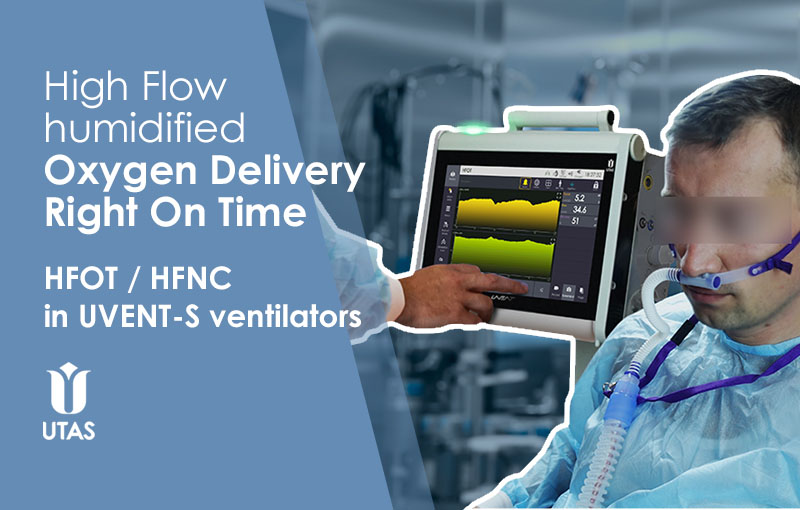
HFOT: Unlocking the Benefits of High-Flow Oxygen Therapy in UVENT-S ICU Ventilators (VIDEO)
High-Flow Oxygen Therapy (HFOT) is a medical treatment that delivers a high flow of heated and humidified oxygen to the patient via nasal cannula (HFNC). It is widely used in the management of respiratory conditions such as acute respiratory failure, pneumonia(1), and chronic obstructive pulmonary disease(2). Compared to conventional oxygen therapy, HFOT provides significantly higher flow rates(3), which can enhance oxygenation and reduce the work of breathing(4).
That’s why we paid special attention to implementing HFOT in our ventilators. Our focus was on maximizing patient comfort and safety during non-invasive respiratory support, while also enabling greater flexibility and responsiveness in therapy. The dedicated HFOT mode in UVENT-S ICU ventilators offers a number of clinical and operational advantages.
Advantages of HFOT in UVENT-S ventilators
• Wide range of flow rate setting (up to 80 l/pm) to facilitate the setup to increase FRC and effectively compensate early signs of respiratory failure.
— Provides clinicians with precise control over the intensity of non-invasive respiratory support, enabling flexible adjustment for individual patient needs.
• Automatic oxygenation therapy based on SpO2 feedback with timely control and maintenance of minimum-effective inspired oxygen concentration.
— Reduces manual workload, prevents desaturation peaks, and supports consistent oxygen titration during long-term therapy.
• High-quality humidification and heating of the breathing mixture for optimal breathing comfort.
— UVENT-S is compatible with humidifiers from various manufacturers, both with and without servo-control, allowing clinicians to finely tune the conditioning of the breathing mixture. This ensures optimal airway moisture and temperature, improving patient comfort and reducing airway irritation during prolonged oxygen therapy.
• Compatible with high-flow O2 cannulas.
— Supports a wide range of certified nasal cannulas, enabling seamless application across adult and pediatric categories, including during weaning from invasive ventilation.
• The mode is already included in the basic configuration of the UVENT-S.
— No additional modules, upgrades, or software licenses required — ready for use out of the box, reducing setup time and total cost of ownership.

HFOT clinical applications
• Acute Respiratory Failure: HFOT is commonly employed in the management of patients with acute respiratory failure, whether due to conditions like pneumonia, acute respiratory distress syndrome (ARDS), or other respiratory illnesses (1).
• Chronic Obstructive Pulmonary Disease (COPD): It may be used in exacerbations of COPD to provide respiratory support and improve oxygenation. (2)
• Hypoxemic Respiratory Failure: HFOT may be considered for patients with hypoxemic respiratory failure who require a higher level of oxygen support. (3)
• Post-Operative Care: HFOT can be utilized in the post-operative period, especially for patients recovering from thoracic or upper abdominal surgeries. (5)
• Preventing Intubation: Among patients with acute hypoxaemic respiratory failure, HFNC was proven to avoid intubation compared to conventional oxygen devices. (6,7)
NOTE! This list is not a recommendation or direct instruction for action by physicians. It does not replace the clinical judgment of a physician and is not to be used for clinical decision-making purposes. Also, the list does not claim to be a complete description of the range of clinical applications.
Essentially, the therapy aims to enhance oxygenation, reduce the work of breathing, and improve respiratory comfort for patients with respiratory distress. While HFOT is a valuable tool in respiratory care, its appropriateness and effectiveness depend on the specific clinical context and the patient’s condition. Medical professionals assess and prescribe HFOT based on individual patient needs and the underlying respiratory pathology.
1. Masclans J, Pérez-Terán P, Roca O, The role of high flow oxygen therapy in acute respiratory failure. Med Intensiva, 2015 Nov;39(8):505-15, doi: 10.1016/j.medin.2015.05.009
2. Dolidon S, Dupuis J, et al. Characteristics and outcome of patients set up on high-flow oxygen therapy at home. Ther Adv Respir Dis. 2019 Jan-Dec; doi: 10.1177/1753466619879794
3. Frat J, Coudroy R, et al. High-flow nasal oxygen therapy and noninvasive ventilation in the management of acute hypoxemic respiratory failure. Ann Transl Med. 2017 Jul; 5(14): 297. doi: 10.21037/atm.2017.06.52
4. Veenstra P, Veeger N, et al. High-flow nasal cannula oxygen therapy for admitted COPD-patients. A retrospective cohort study. PLoS One. 2022; 17(10), doi: 10.1371/journal.pone.0272372
5. Zhonghua L, Wei C, et al. High-flow oxygen therapy in postoperative patients: a systematic review and meta-analysis. Critical Care Medicine 47(1):p 543, January 2019, doi:10.1097/01.ccm.0000551878.81865.14
6. Rochwerg B, Granton D, Wang DX, et al. High flow nasal cannula compared with conventional oxygen therapy for acute hypoxemic respiratory failure: a systematic review and meta-analysis. Intensive Care Med 2019; 45: 563–572. doi: 10.1007/s00134–019–05590–5
7. Li J, Jing G, Scott JB. Year in review 2019: high-flow nasal cannula oxygen therapy for adult patients. Respir Care 2020; 65: 545–557. doi: 10.4187/respcare.07663 Abstract/FREE Full Text



